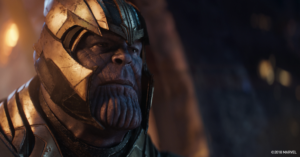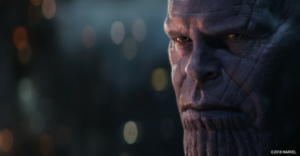
Francesco Panzieri is no stranger to big hits, both in television and film. Panzieri’s name has been included in the credits for Spider-Man: Homecoming, Star Wars: The Force Awakens, Mad Men, True Detective, Westworld, and many others.
Still, the New York Film Academy alum’s most recent work on Marvel’s Avengers: Infinity War may be the biggest film he has worked on to date. The superhero blockbuster raked in $630 million on its opening weekend, which is the biggest opening of all time.
The digital effects compositor sat down with us to discuss Avengers, his upcoming projects, and how his time at NYFA helped prepare him for career.
NYFA: How did your experience on Infinity War compare to the other Marvel films you’ve worked on?
Francesco Panzieri: On my first Marvel movie, Spider-Man: Homecoming, I was actually working in-house within Marvel Studios, where I was tasked with 2D live-action visual effects. As such, my work scope was compositing actors from green screen onto photographed backgrounds, monitor insert, wire removal, plate re-timing, re-positioning, scale-up and split-screen.
On Thor: Ragnarok and eventually Avengers: Infinity War, the team at Digital Domain had to deal with some intricate compositing of CG characters onto live-action plates. I came aboard late in the game on Thor, yet I was still lucky to get some cool looking shots, including the composite of a blue-screen take of Chris Hemsworth over a fully-CG environment in the Sakaar chase sequence, where Thor smashes the engine of a spaceship barehanded.
On Avengers, stakes got higher. Almost every one of our shots in the sequence featured Thanos versus an Avenger; I was very lucky to get him in each of my five shots and by getting to work on one of the trailer shots released to the public two months before the movie came out. Captain America and Thor were the other two characters in my shots, so I also focused on locking down their hands onto Thanos’ gauntlet and head, to make sure that the audience would really perceive that rock solid hold as the Avengers attempt to save half the universe.
DD had developed a technique to color-grade Thanos in a photo-realistic yet nonhuman way while adding some splash of purple on selected areas of his face and body. We also made a great use of the subsurface scattering render-layer to fine-tune his color and deep ID’s for his stubble and hair. Thanos was fully rendered in VRay with many proprietary skin shaders that DD has been continually refining for years; all the compositing was done in Nuke.
NYFA: Was it harder to deal with mo-cap and completely CG characters like Thanos, Groot, and Rocket, or easier to incorporate VFX in their scenes?
Francesco: The photo-realism that Digital Domain was trying to achieve on this feature definitely pushed the CG characters to be the most-challenging part. The team really cared about giving them a perfect fitting in the scene under every point of view. We made sure that black levels matched accurately to the live-action plate and brainstormed every possible interactive light from the environment onto the characters and vice versa.
Ultimately, during every session of dailies, the supervisors kept asking, “How can we make the shot look spectacular?” or ‘What is this shot missing from looking memorable?” For Thanos, we had some great rigging work done to enhance all the muscle tension from Josh Brolin’s performance onto his digital character to help perceive the struggle during the fight scenes, as well as the weight he is bringing in the game to fight the Avengers.
All of the Thanos work you see in the movie, with the exception of the sequence on Titan, belongs to the tireless work of the artists at Digital Domain.
NYFA: How much direction, or conversely, freedom, are you given by the directors when crafting VFX?
Francesco: It can vary. As previously mentioned, with Marvel, if you’re tasked with something that has already been done in their previous movies, you can rest assured that they will ask you to stay on that same beaten path. Of course, your work might exceed their expectations in terms of presentation and integration, but they really care about keeping the continuity with their previous movies as the MCU is a big shared playground.
On another note, if you’re being asked to introduce something new to the visual story, you can really push the limit of your creativity and submit different versions for their review, as long as you also keep in mind what your VFX supervisor asks you to do and that your work must look coherent with the storytelling.

NYFA: Was it easier creating VFX taking place in NYC and the real world or easier creating them in the totally made-up space fantasy worlds?
Francesco: It is always easier to work with a photographed plate as a reference for compositing anything over it. Trying to create a fully CG environment without any real photographic reference can really make things unfriendly, unless you know precisely what you’re aiming at and what you want it to look like. The flexibility that comes with it can very well be a double-edged weapon if you’re on a tight deadline, however it also gives you plenty of creative freedom to fully express the storytelling.
NYFA: How did NYFA prepare you for this particular job?
Francesco: NYFA trained me to work very hard and for long hours. I was able to grasp a solid knowledge of 2D and 3D during my time there, thanks to a very organic and inclusive approach to the art of filmmaking and storytelling. I was able to develop technical and artistic skills that could help me find a job once I graduated, and I had a fantastic time during my studies.
NYFA is excited Francesco’s upcoming work following the tremendous success of Avengers: Infinity War. You can learn more about him and his credits on his website.
Our one-year program in animation is designed for students looking to develop their visual effects skills and gain hands-on experience with animation tools and softwares. Visit our 3D Animation One-Year Program page to learn more.